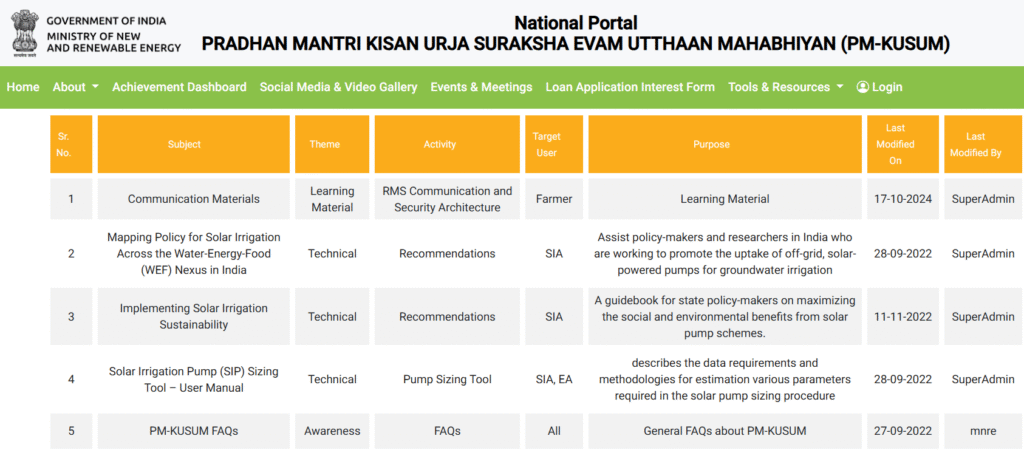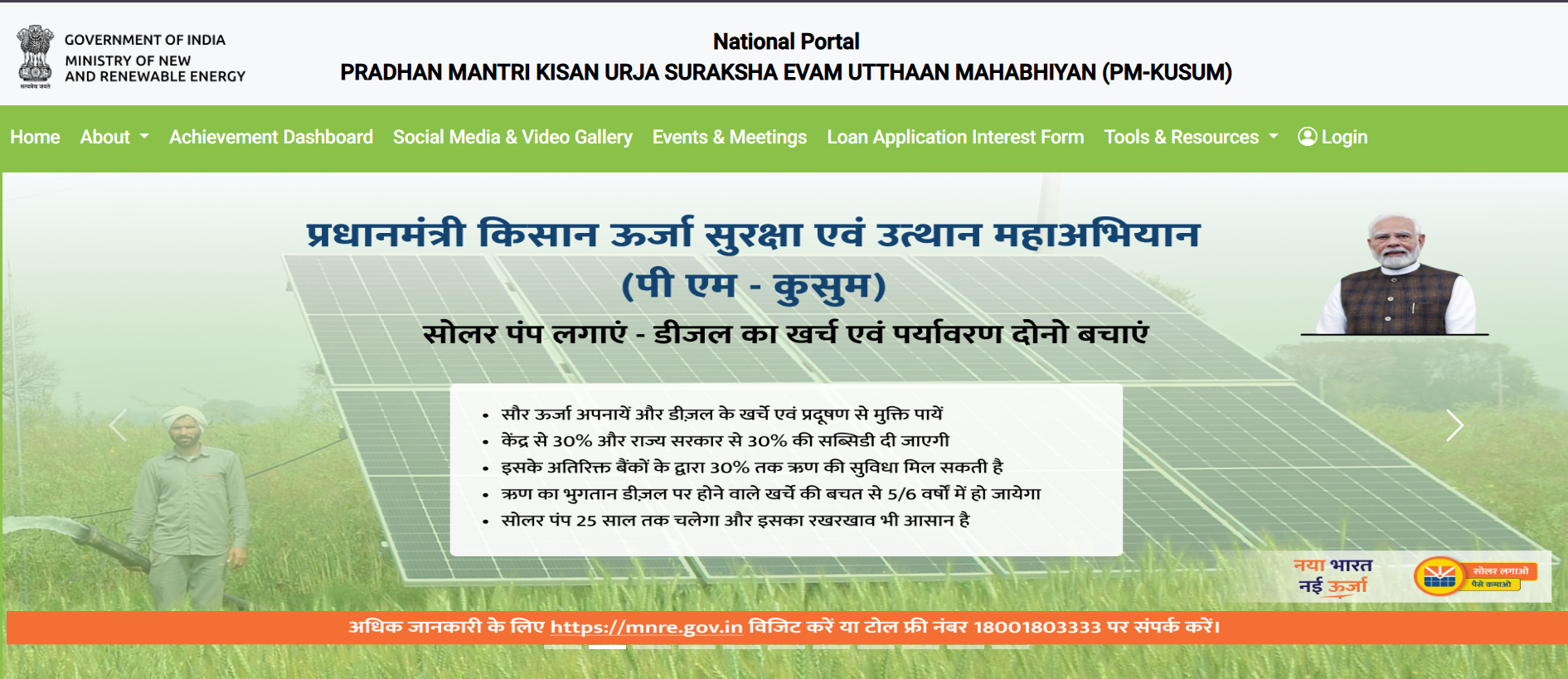PM KUSUM Yojana 2025: Solar Pump Price, Subsidy & Online Registration (Complete Guide)
If you’re a farmer, a Farmer Producer Organization (FPO), a rural entrepreneur or a solar distributor, the PM KUSUM Yojana should be on your radar. It’s the government’s flagship program to put clean solar energy on farms, reduce diesel and electricity bills, and create new income streams by selling surplus power to the grid.
This guide explains everything you need to know: what the scheme is, how the subsidy works, estimated pump costs, how to apply online, state-level nuances, and practical tips to avoid fraud and delays. Read on — this could reshape your farm’s future.
What is the PM KUSUM Yojana?
PM KUSUM stands for Pradhan Mantri Kisan Urja Suraksha evam Utthaan Mahabhiyan. Launched by the Government of India through the Ministry of New and Renewable Energy (MNRE), the scheme promotes solar energy adoption in agriculture to ensure energy security, reduce dependence on diesel, and provide a new income source for farmers.
At its core, KUSUM aims to:
- Provide reliable daytime power for irrigation,
- Promote decentralized solar power generation, and
- Reduce the financial burden on electricity distribution companies (DISCOMs).
Official information and application portals are available at the national PM KUSUM site and MNRE’s website:
Why KUSUM Matters for Farmers
Agriculture faces two power problems: unreliable grid supply and expensive diesel costs. Together they increase the cost of irrigation and reduce productivity. Solar pumps solve both:
- Lower operating costs: Solar eliminates diesel expense and reduces electricity bills.
- Reliable irrigation: Solar pumps give predictable daytime watering for critical crop stages.
- Additional income: Under some components, surplus power can be sold to the grid.
- Environmental benefits: Less diesel usage = lower carbon emissions and cleaner air.
If you want to reduce input costs and stabilize irrigation, KUSUM is a practical route.

The Three Components of KUSUM — Which One Is Right For You?
KUSUM is designed with three components to suit different farmer needs.
Component A — Decentralized Solar Power Plants (Grid-Connected)
This lets farmers, FPOs, or entrepreneurs set up solar plants (typically 500 kW to 2 MW) on barren land and sell power to DISCOMs. It’s ideal if you own fallow land and want steady lease/rental or power-sale income.
Component B — Standalone Solar Agriculture Pumps (Most Farmer-Focused)
This component is for off-grid standalone solar irrigation pumps (substitute diesel pumps). Up to a capped capacity (often 7.5 HP equivalent for subsidy calculations), farmers can get panels + pump systems with central & state subsidies. It’s the simplest way for smallholders to move away from diesel.
Component C — Solarisation of Grid-Connected Pumps
If you have an existing grid-connected electric pump, Component C helps you solarize it. Daytime solar powers the pump; any surplus can be fed to the grid. This can be done at individual pump level or feeder level (for wider benefits).
Subsidy Structure — How Much Does Government Pay?
Subsidies are the main reason farmers opt for KUSUM. The typical structure (subject to state variations) is:
- Central Financial Assistance (CFA): ~30% of the benchmark cost (some cases 50% in hilly/NE regions).
- State Government Subsidy: ~30% (varies by state).
- Farmer Contribution: The remaining ~40%, often financed via bank loans so farmer’s initial outlay can be as low as 10% in many scenarios.
Note: Several states provide additional incentives for small & marginal farmers — in some cases reducing farmer share further (e.g., 90% subsidy in exceptional state-led schemes). Always verify current state circulars and subsidy rules.
Typical Costs — PM KUSUM Price List (Indicative)
Actual prices vary by vendor, pump type (surface/submersible), panel efficiency and region. Here’s an indicative cost range (before subsidy) to help you plan:
| Pump Capacity | Indicative System Cost (Before Subsidy) |
|---|---|
| 2 HP | ₹1.2 – 2.2 lakh |
| 3 HP | ₹1.8 – 3.0 lakh |
| 5 HP | ₹3.0 – 4.0 lakh |
| 7.5 HP | ₹4.0 – 6.0 lakh |
With a typical 60% combined government subsidy (30% central + ~30% state), your net cost could be ~10–40% of the installed price depending on financing options and state-level support. Always ask vendors for a detailed subsidy breakup.
Who Can Apply? Eligibility Checklist
Primary eligible entities:
- Individual landholding farmers (with land records),
- Farmer Producer Organizations (FPOs), Water User Associations (WUAs),
- Panchayats, cooperatives, and entrepreneurs (especially for Component A).
Essential documents typically required:
- Aadhaar card (mandatory for e-KYC),
- Land ownership records (Khasra/Jamabandi/Khatauni),
- Bank account details for subsidy DBT,
- Passport-size photo, mobile number for OTP.
States may require additional documents — check your state’s portal for exact requirements.
How to Apply: PM KUSUM Yojana Online Registration (Step-by-Step)
Step 1: Visit the official portal
Go to the national portal at https://pmkusum.mnre.gov.in or your state’s PM KUSUM portal. Use only official sites to avoid fraud.
Step 2: Choose your component (A, B or C) based on your need.
Step 3: Fill out the online registration form
Provide personal details, land & bank details, and pump specifications.
Step 4: Upload documents
Upload Aadhaar, land records, bank passbook/cheque copy etc. as per format & size guidelines.
Step 5: Submit & note your application number
You’ll get a reference number for tracking.
Step 6: Verification and sanction
State nodal agencies verify applications, perform a site inspection if needed, and sanction installations. Approved vendors install equipment under state supervision.
Offline help: If you face internet issues, use Common Service Centres (CSCs) or visit your state nodal agency or DISCOM office for assisted registration.
State-Level Programs — Success Stories & What to Learn
Some states have run strong campaigns to scale up KUSUM adoption:
- Maharashtra (Maha Krushi Urja Abhiyan) has prioritized one pump per farmer and anti-fraud enforcement.
- Rajasthan focused on Component A by utilizing fallow land for decentralized plants.
- Other states are active with dedicated portals and local vendor empanelment.
Takeaway: Each state customizes implementation — always use your state portal for the most accurate guidance.
Common Issues & How to Avoid Them
Delays in subsidy disbursement: Keep documents updated, ensure Aadhaar-bank linking and follow up with the State Implementing Agency (SIA).
Fake vendors & upfront payments: Use only empanelled vendors from state/national listings. Never pay heavy cash advances to unknown agents.
Registration failures: Apply in off-peak hours, use CSCs or local agriculture offices for assistance, and ensure document scans are clear and in the correct format.
Land record mismatches: Resolve issues with Tehsildar office or Village Revenue Officer before application.
Practical Tips to Maximize ROI
- Choose the right pump capacity based on irrigation needs and crop water demand.
- Request a full subsidy breakup from vendors. Compare quotes from multiple empanelled vendors.
- Get warranty and performance guarantees in writing.
- Ask for after-sales service packages — panel cleaning, inverter checks, and pump maintenance.
- Consider feeder-level solarisation for community benefits if individual installation isn’t viable.
FAQs (Optimized for Search)
Q: What is the official PM KUSUM website?
A: The national portal is https://pmkusum.mnre.gov.in. Also consult https://mnre.gov.in for policy details.
Q: How much subsidy is given?
A: Standard structure is ~30% central + ~30% state. Some regions get higher central assistance (50%) or enhanced state support for small & marginal farmers.
Q: Can tenant farmers apply?
A: Rules vary by state. Tenant farmers typically need valid tenancy agreements or NOC from landowners.
Q: How to check application status?
A: Use your application reference number on the state portal or the national portal’s tracking feature.
Q: Is there a registration fee?
A: Most states do free registration; some may charge nominal processing fees. Verify with your state nodal agency.
Why Bhumi Growth Solutions Recommends Acting Now
At Bhumi Growth Solutions, we’ve helped farmers evaluate pump sizes, secure vendor quotes and navigate state subsidy processes. Going solar now can drastically reduce irrigation costs, improve reliability and open new income streams. Our services include vendor shortlisting, documentation assistance and after-sales maintenance.
Ready to go solar? Contact us for a free farm assessment and subsidy calculation.
Final Word
The PM KUSUM Yojana is not just a subsidy program — it’s a structural step toward energy-secure and climate-smart farming. With strong government support, state variations, and bank financing options, now is an excellent time to adopt solar irrigation.
Visit the official portal https://pmkusum.mnre.gov.in and the Ministry’s site https://mnre.gov.in to check detailed guidelines and your state’s implementation plan. If you need help — from paperwork to vendor selection — Bhumi Growth Solutions can guide you every step of the way.
Read more information by clicking here – official government document pdf file.
Act today: solar pumps cut costs, stabilize irrigation and build a sustainable income for the future.



